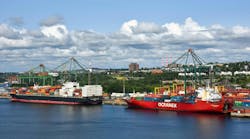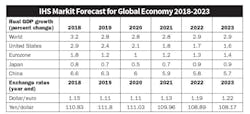Two interrelated and troubling developments are coloring the global economic picture. First, trade growth is slowing sharply. The IHS Markit Purchasing Managers’ Index (PMI) for new exports has been falling for six months in a row — the largest drop since 2016. Second, the global manufacturing PMI highlights the stagnation in the industrial sectors.
Key economies whose manufacturing industries are in recession include the Eurozone, Japan and China. While U.S. protectionist policies have worsened the outlook for trade volumes and factory output in many parts of the world, the industrial recession in China — brought on by the government’s deleveraging campaign — is, arguably, a bigger drag. The good news is the Chinese government has (once again) begun to provide modest stimulus. This move will stabilize manufacturing in China and the other parts of the world. Equally encouraging is the lack of “contagion” from manufacturing to services. Both these trends will sustain growth for a while.
United States. IHS Markit/Global Insight sees the U.S. economy downshifting to 2%. Real GDP grew at a 2.6% annual rate in the fourth quarter of 2018; full-year growth was 2.9%, a pace bolstered by tax cuts and federal spending increases. In the very near term, GDP growth has slowed sharply, to about 1.3%, reflecting a sharp, but temporary deceleration in consumer expenditures in the wake of December’s financial market turbulence and a reversal of a weather-induced surge in utility bills late last year.
Real GDP growth is forecast to increase 2.4% in 2019 and 2.1% 2020, as the boost from fiscal stimulus first peaks and then fades. After 2020, GDP growth is projected to ease further to a 1.7% annual average through 2023. The unemployment rate, after bottoming out at 3.5%, is forecast to drift higher — a profile that we think balances the risks between an outlook of continuing trend growth and an outright recession. Financial conditions have improved of late, with equity values starting off this month’s forecast about +5% higher than last month, and both term and risk spreads starting somewhat lower.
Europe. More evidence of weak growth, but a recession is still not the most likely outcome. The Eurozone’s real GDP growth in the fourth quarter of 2018 was confirmed at a soft 0.2% quarter on quarter (Q/Q). Year-on-year (Y/Y) growth was revised down slightly to 1.1%, the lowest rate in five years. The industrial sector was already in recession in the second half of 2018, as evidenced by the IHS Markit PMIs.
The risk of an economy-wide recession stems from ongoing spillovers and event risks (a “no-deal” Brexit and U.S. auto tariffs). Nevertheless, growth supports include rising household real income, supported by lower oil prices and sustained employment growth; easing fiscal policies; and a rebound from event- and sector-specific drags in the second half of 2018 (weather and emissions testing in Germany).
China. The Lunar New Year distorts the data, but the underlying fragility is apparent. At the opening of the recent National People’s Congress, Premier Li Keqiang announced China’s 2019 real GDP growth target will be 6% to 6.5%, a range consistent with the IHS Markit forecast of 6.3%. Growth momentum will moderate with a weakening in real estate markets and foreign trade. Faster growth in infrastructure investment and tax cuts will help to counter the slowdown. January economic data are scant, as the Chinese authorities do not report most economic indicators for January and February individually because of the shifting Lunar New Year.
Other large emerging markets are showing the strain. Data on recent growth trends in the emerging world have been disappointing. Some economies, such as Argentina, Iran and Turkey, have already slipped into recession. Others such as Brazil, India and South Africa have seen growth fall below expectations. While a few countries (India, the Philippines and Vietnam) will continue to grow at robust rates, others will struggle to achieve growth rates above 1% to 2%. The latter group includes Brazil, Saudi Arabia and South Africa.
Reasons for this poor performance are clear. Growth in the developed world is slowing sharply and commodity prices are flat to down. The industrial recession in key economies, especially China, is hurting emerging-market exports, as is the trade war between China and the United States. A case in point is the plunge in export growth of two Asian powerhouses, South Korea and Taiwan. Geopolitics is also a growing risk. The escalating tensions between India and Pakistan are a big threat to a region that has performed better than most over the past few decades.
The bottom line is that growth is slowing everywhere in the global economy. It’s encouraging that policymakers seem concerned enough to do what is necessary (within limits) to prevent a recession.
—IHS Markit Chief Economist Nariman Behravesh and Sara Johnson, Executive Director, Global Economics










